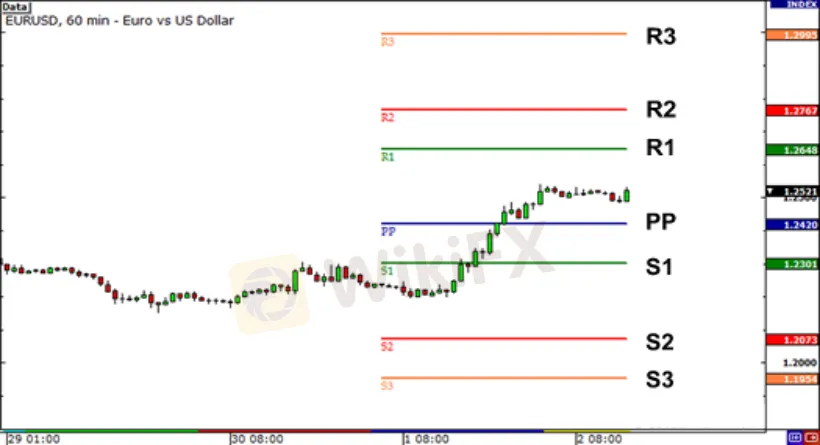简体中文
繁體中文
English
Pусский
日本語
ภาษาไทย
Tiếng Việt
Bahasa Indonesia
Español
हिन्दी
Filippiiniläinen
Français
Deutsch
Português
Türkçe
한국어
العربية
What are pivot points?
Abstract:One tool that provides forex traders with potential support and resistance levels and helps to minimize risk is the pivot point and its derivatives. The use of reference points such as support and resistance, help determine when to enter the market, place stops, and take profits.
One tool that provides forex traders with potential support and resistance levels and helps to minimize risk is the pivot point and its derivatives. The use of reference points such as support and resistance, help determine when to enter the market, place stops, and take profits. A pivot point and its support/resistance levels are areas at which the direction of price movement can possibly change.
What makes pivot point so attractive is because they are OBJECTIVE. Not as some of the other indicators that we have discussed with you about already, where theres no discretion involved.
There are many ways in which forex pivot points and Fibonacci levels looks similar. Because so many people are looking at those levels, they almost become self-fulfilling. The major difference between the two is that with Fibonacci, there is still some bent involved in picking Swing Highs and Swing Lows. And With pivot points, forex traders typically use the same method for calculating them.
Most traders concentrate on these levels and you should too. Pivot points are mostly useful to short-term traders who are looking to take advantage of small price movements. Just like normal support and resistance levels, forex traders can choose to trade the bounce or the break of these levels.
Range-bound traders, traders that buy at the support trendline and sell at the resistance trendline level for a given stock or option, use pivot points to identify reversal points. They consider pivot points as areas where they can place their buy or sell orders. While Breakout forex traders,
Traders that place stop-loss points just above the upper and lower trend lines to avoid having heavy losses from high-volume breakouts, use pivot points to recognize key levels that need to be broken for a move to be classified as a real deal breakout.
Below is an example of pivot points plotted on a 1-hour EUR/USD chart:

As you can see clearly above, horizontal support and resistance levels are placed on your chart. They also marketed out already for you, how suitable is that?
Pivot Point Lingo
Let's take a quick review on what those acronyms mean:
PP stands for Pivot Point.
S stands for Support.
R stands for Resistance.
But don‘t get too amazed or confused in thinking “S1 has to be support!” or “R1 has to be resistance.” We’ll explain why later in details.
As we proceed further, you will also learn how to calculate forex pivot points In the next lessons, the different types of pivot points, and most importantly, how you can add pivot points to your forex trading toolbox in the next lesson.
Disclaimer:
The views in this article only represent the author's personal views, and do not constitute investment advice on this platform. This platform does not guarantee the accuracy, completeness and timeliness of the information in the article, and will not be liable for any loss caused by the use of or reliance on the information in the article.
Read more

Forex is a game that I enjoy playing
These champions have one thing in common: they not only work their butts off, but they also enjoy what they do.

Wait patiently. Maintain your discipline
"Patience is the key to everything," American comic Arnold H. Glasgow once quipped. The chicken is gotten by hatching the egg rather than crushing it."

There isn't a Holy Grail to be found!
Ask any Wall Street quant (the highly nerdy math and physics PhDs who build complicated algorithmic trading techniques) why there isn't a "holy grail" indicator, approach, or system that generates revenues on a regular basis.

Concentrate on the Process. Profits aren't a priority
We've designed the School of WikiFX as simple and enjoyable as possible to help you learn and comprehend the fundamental tools and best practices used by forex traders all over the world, but keep in mind that a tool or strategy is only as good as the person who uses it.
WikiFX Broker
Currency Calculator







